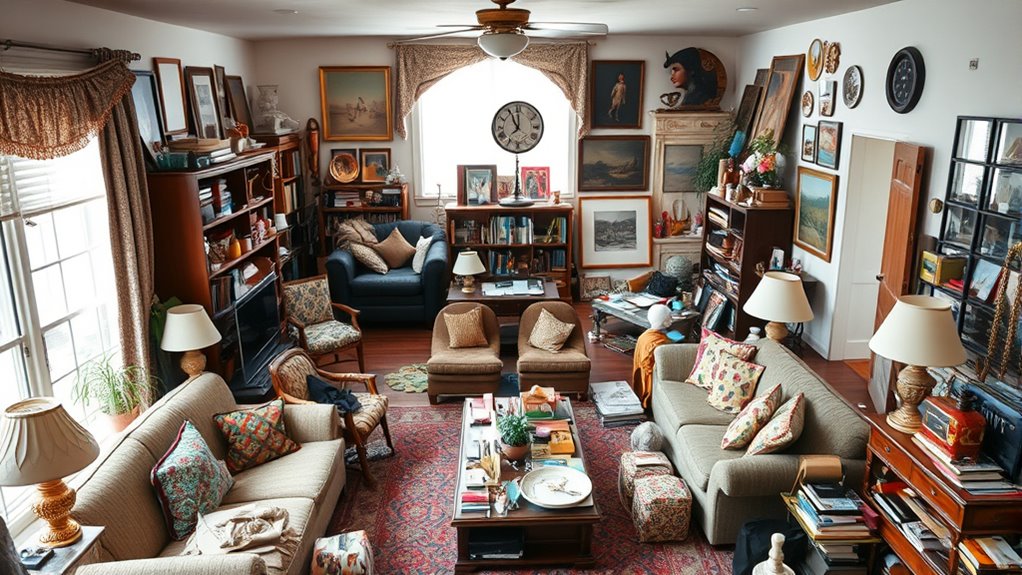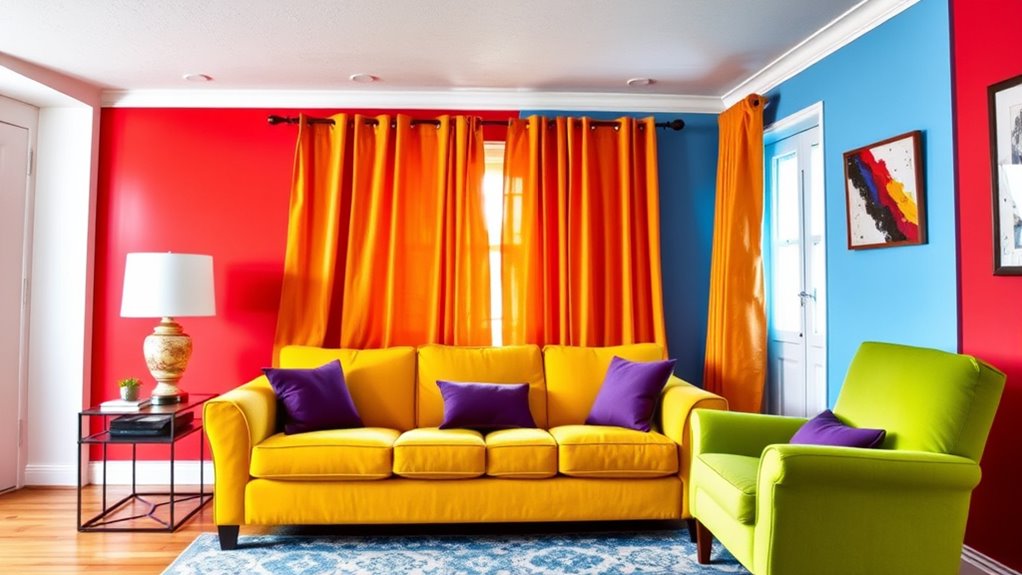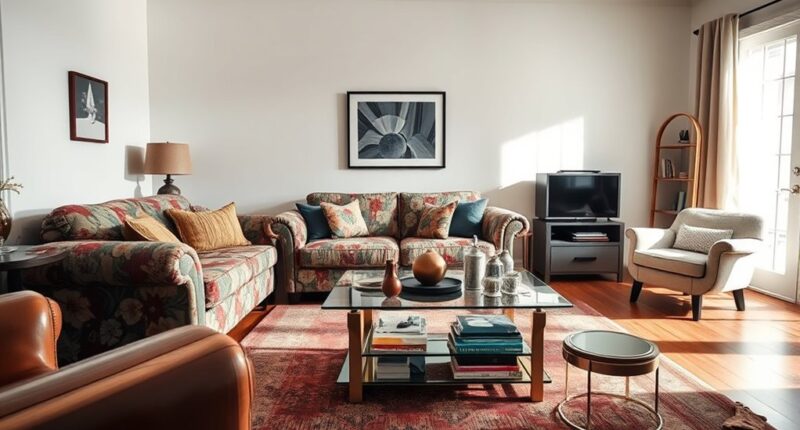To avoid common decorating mistakes, steer clear of overloading your space with too many items, which creates clutter and chaos. Make sure your lighting is balanced to enhance mood and functionality. Choose colors that work well together to prevent visual clashes. Pay attention to scale and proportion so furniture fits properly. Establish a cohesive style to tie everything together and avoid skimping on quality, which can cost you more in the long run. Keep your furniture arrangement thoughtful, and you’ll create a more inviting space—you’ll find out how to master these tips next.
Key Takeaways
- Avoid clutter by limiting decorative items and maintaining a cohesive style throughout the space.
- Use proper lighting and coordinate colors to create a balanced, inviting atmosphere.
- Ensure furniture scale and materials are appropriate for the room size to enhance comfort and durability.
- Plan furniture arrangement thoughtfully to optimize space flow and functionality.
- Prioritize quality over cost to prevent frequent repairs and ensure long-term aesthetic appeal.
Overloading a Space With Too Many Items

Overloading a space with too many items can make it feel cluttered and overwhelming. When you pack a room with excessive furniture, accessories, or decor, it creates cluttered aesthetics that distract the eye. Instead of a cohesive look, you’ll notice visual chaos, which hampers relaxation and makes the space seem smaller. Avoid the temptation to fill every nook; instead, choose a few statement pieces that stand out. Clear surfaces and open spaces help your room breathe, making it feel more inviting and organized. Remember, less is often more. By editing your decor and keeping only what you truly love and need, you create a balanced environment that’s calm, functional, and visually appealing. Cultivating resilience through persistence in your decorating choices can help you stay committed to a clean, organized space even when faced with clutter temptation.
Ignoring the Importance of Lighting

Lighting plays a crucial role in shaping the atmosphere and functionality of a space, yet it’s often overlooked during design. Without proper lighting, rooms can feel dull or uninviting. You need to incorporate task lighting for specific activities, like reading or cooking, and accent illumination to highlight artwork or architectural features. Neglecting this balance can make your space feel flat or poorly functional. Here’s a quick overview:
| Lighting Type | Purpose | Best Placement |
|---|---|---|
| Task Lighting | Focused tasks, e.g., reading | Over desks, kitchen counters |
| Accent Illumination | Highlight features | Spotlights on art or niches |
| Ambient Lighting | Overall room brightness | Ceiling fixtures, sconces |
| Natural Light | Daylight | Windows, skylights |
| Layered Lighting | Balance and flexibility | Mix of all above |
Proper lighting ensures your space is both beautiful and practical. Additionally, understanding lighting layers can help you create a well-balanced and inviting environment.
Choosing Colors That Clash

Choosing colors that clash can turn a well-designed space into a visual headache. When selecting hues, consider color psychology to evoke the right mood and atmosphere. Avoid mixing bold, contrasting colors without a plan, as this disrupts color coordination and creates visual chaos. For example, pairing overly warm tones with cool shades can feel jarring, unless intentionally done for effect. Instead, stick to a harmonious color palette that complements each element in the room. Use tools like color wheels to identify complementary or analogous colors, ensuring your choices blend seamlessly. Remember, successful decorating relies on balance and unity; clashing colors undermine that harmony and can make your space feel chaotic and uninviting. Choose wisely, and let color psychology guide your decisions. Additionally, understanding color schemes can help you create a more cohesive and appealing environment.
Neglecting Scale and Proportion

If you choose furniture that’s too big, it can overwhelm your space and make it feel cluttered. Conversely, tiny pieces in a small room can create a cramped, uncomfortable vibe. To achieve a balanced look, pay attention to how proportions and scale work together in your decor. Incorporating remote collaboration techniques can help visualize how different furniture sizes will fit within your space before making a purchase.
Oversized Furniture Overwhelm
Oversized furniture can quickly make a room feel cramped and out of balance if you neglect to contemplate scale and proportion. When choosing pieces, pay close attention to furniture proportions to guarantee they fit comfortably within the space. Large furniture items that overwhelm the room can disrupt room harmony, making the area feel cluttered and uncomfortable. To avoid this, measure your space carefully and select furniture that complements the room’s size. Opt for scaled-down pieces in smaller rooms to maintain a balanced look. Remember, harmony in furniture proportions creates a cohesive environment where each piece enhances the overall design. Oversized furniture may seem impressive, but it can backfire by dominating the space and sacrificing comfort. Balance is key for a well-designed, inviting room. Additionally, incorporating furniture scale thoughtfully ensures your bedroom remains comfortable and visually appealing.
Small Rooms Feel Cramped
When scale and proportion aren’t carefully considered, small rooms can quickly feel cramped and overwhelming. To avoid this, choose space enhancing furniture that fits well within the room’s dimensions, instead of bulky pieces that dominate the space. Opt for sleek, streamlined furniture that provides function without clutter. Incorporate vertical storage solutions like tall shelves or wall-mounted units to maximize height and free up floor space. This creates an illusion of openness while providing necessary storage. Avoid overcrowding the room with oversized furniture or too many accessories. Instead, focus on proportionate pieces that complement the room’s size, making it feel more spacious and inviting. Properly scaled furniture and smart storage are key to transforming a cramped space into a comfortable, well-balanced room. Additionally, understanding design principles can help you make better choices that enhance the room’s overall harmony and visual appeal.
Balance in Decor
Neglecting scale and proportion in your decor can quickly tip the balance from stylish to chaotic. When furniture and accessories aren’t sized correctly, your space feels off. Aim for symmetry in decor to create visual harmony, balancing larger pieces with smaller accents. This approach helps maintain a sense of order and calm. Remember to emphasize a focal point; whether it’s a fireplace, artwork, or statement furniture, scale should highlight it without overwhelming the room. Proper interior design planning ensures each element complements the others, preventing cluttered or sparse arrangements. When you pay attention to scale and proportion, your decor effortlessly guides the eye and enhances the overall balance. This careful attention creates a cohesive, inviting environment that feels both intentional and comfortable.
Failing to Establish a Cohesive Style

A lack of a cohesive style can make your design feel disjointed and confusing. To create a unified space, focus on theme consistency. Decide on a central style—modern, rustic, or eclectic—and stick with it throughout the room. Avoid mixing styles haphazardly, which can lead to style blending that feels chaotic rather than intentional. Instead, choose complementary furniture, colors, and accessories that reinforce your chosen theme. This consistency helps your decor flow seamlessly and creates a harmonious atmosphere. If you want to combine different elements, do so thoughtfully, ensuring they enhance rather than clash with each other. Remember, a cohesive style makes your space feel intentional and polished, rather than cluttered or confused. Incorporating visual and auditory elements thoughtfully can also elevate the overall cohesiveness of your space.
Skimping on Quality for Cost Savings

Choosing cheap materials might save you money upfront, but they often lack durability and can wear out quickly. While it seems like a good deal now, these short-term savings can lead to costly repairs or replacements later. Ultimately, skimping on quality can inflate your long-term costs far beyond what you initially saved. Incorporating cost of living adjustments into your budgeting can help better prepare you for unexpected expenses down the line.
Cheap Materials Lose Durability
Opting for cheap materials might seem like a way to save money initially, but it often leads to long-term problems. Low-quality options tend to wear out quickly, requiring frequent repairs or replacements. This defeats the purpose of saving money and can damage your space’s appearance. Instead, focus on selecting cost-effective materials that balance affordability with durability. These budget-friendly options ensure your decor remains intact over time. To understand the impact, consider this table:
| Material Type | Durability | Cost Effectiveness |
|---|---|---|
| Cheap laminate | Low | Short-term savings |
| Solid hardwood | High | Long-term value |
| Veneer | Moderate | Budget friendly options |
| Laminate countertops | Moderate | Cost effective materials |
| MDF panels | Low | Short-lived, budget use |
Choosing quality guarantees longevity, saving you money in the long run. Additionally, understanding material durability can help you make smarter choices for lasting home decor.
Short-Term Savings, Long-Term Costs
While skimping on quality may provide immediate savings, it often results in higher costs over time. Cutting corners on materials or craftsmanship can lead to frequent repairs, replacements, and increased maintenance, turning initial savings into ongoing expenses. This is a common investment pitfall that hampers your long-term budget planning. When you prioritize short-term cost savings over durability and quality, you risk sacrificing the longevity of your decor and incurring costs that outweigh the original savings. Instead, focus on investing in well-made pieces that may cost more upfront but will save you money in the long run. Making thoughtful choices today ensures your space remains stylish and functional, avoiding costly mistakes that compromise your budget’s effectiveness over time.
Poorly Arranged Furniture Layouts

Poorly arranged furniture can quickly turn a functional space into a frustrating one. When your furniture layout isn’t thoughtfully planned, it hampers movement and creates clutter. Effective furniture arrangement is key to maximizing space optimization, making rooms feel open and inviting. Avoid blocking doorways, windows, or key pathways, as these disrupt flow and convenience. Instead, position furniture to encourage natural conversation and ease of use. Use scale and proportion wisely—oversized pieces can overcrowd a room, while too-small furniture can make a space feel empty. Keep a balance between function and style, ensuring each piece serves a purpose without crowding the area. Proper furniture arrangement not only improves the aesthetics but also enhances comfort, transforming your space into a more enjoyable environment.
Frequently Asked Questions
How Can I Balance Functionality and Aesthetics Effectively?
To balance functionality and aesthetics, you should prioritize smart storage solutions that keep your space organized without clutter. Incorporate lighting techniques like layered lighting to create ambiance while enhancing practicality. Choose furniture and decor that complement each other in style and purpose. By blending these elements thoughtfully, you’ll create a space that’s both beautiful and highly functional, making everyday living more enjoyable and efficient.
What Are Tips for Mixing Different Design Styles Successfully?
When mixing different design styles, focus on color coordination to create a cohesive look. Use a unifying color palette across furniture and accessories to tie diverse styles together. Make sure furniture harmony by balancing proportions and shapes, so no piece overwhelms the space. Incorporate complementary textures and patterns, and avoid clutter to maintain harmony. This approach helps you blend styles seamlessly, resulting in a stylish, harmonious space that reflects your personality.
How Do I Incorporate Personal Touches Without Cluttering?
When incorporating personal touches, focus on expressing your personality while maintaining clutter control. Choose a few meaningful items that truly reflect you, and display them thoughtfully. Use storage solutions to hide less essential items, keeping your space tidy. Mix in personal elements like artwork or souvenirs sparingly to avoid clutter. This way, your space feels uniquely yours without becoming overwhelming or chaotic, balancing personal expression with a clean, organized look.
What Are Common Mistakes With Window Treatments?
Imagine the perfect window frame, but the treatments fall short. You might choose curtains that hang too long, dragging on the floor, or blinds misaligned, disrupting symmetry. These common mistakes can make your space feel unpolished. To prevent them, guarantee curtain length complements your window height, and double-check blind alignment for a sleek look. Small details like these transform your room from good to stunning.
How Can I Update a Room’S Decor on a Budget?
To update a room’s decor on a budget, you can focus on affordable upgrades like fresh paint or new accessories. DIY projects, such as making your own artwork or repurposing furniture, add personality without breaking the bank. Swap out throw pillows, add a rug, or rearrange existing furniture for a fresh look. These simple, cost-effective ideas help you create a stylish space without overspending, making a big impact with minimal investment.
Conclusion
Avoid these common decorating mistakes to create a space that feels balanced and inviting. Imagine transforming a cramped living room into an open, welcoming area by choosing the right furniture placement and lighting. For instance, a homeowner once packed her living room with too many pieces, making it feel cluttered. After decluttering and focusing on scale, her space became cozy and stylish. Don’t let mistakes hold you back—your ideal home is just a few thoughtful choices away.









